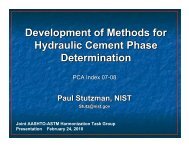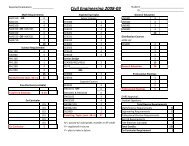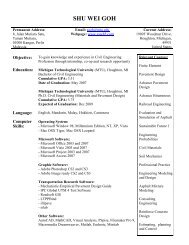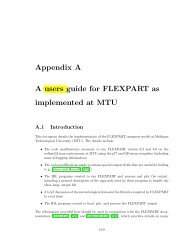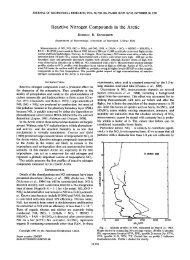Evaluation of Septic Tank and Subsurface Wetland for
Evaluation of Septic Tank and Subsurface Wetland for
Evaluation of Septic Tank and Subsurface Wetland for
You also want an ePaper? Increase the reach of your titles
YUMPU automatically turns print PDFs into web optimized ePapers that Google loves.
Biological Nitrification Reaction (Crites et al., 1998).<br />
NH4 + +1.731O2 +1.962HCO3 - → 0.038C5H7NO2 +0.962NO3 - +1.077H2O +1.769H2CO3<br />
Biological Denitrification Reaction (Crites et al., 1998).<br />
NO3 - + 1.183CH3OH + 0.273H2CO3 0.091C5H7NO2 + 0.454N2 + 1.820H2O + HCO3 -<br />
→<br />
Biologically nitrifying 1.0 g <strong>of</strong> ammonia nitrogen consumes 7.01 g <strong>of</strong> alkalinity <strong>and</strong><br />
denitrifying 1.0 g <strong>of</strong> nitrate nitrogen produces 3.57 g alkalinity (Crites et al., 1998).<br />
Following the above reactions, if 1.0 g <strong>of</strong> ammonia nitrogen is nitrified then<br />
3.57g CaCO3 0.962g NO3-N 1.0g NO3-N × or 3.43 g <strong>of</strong> alkalinity is produced during denitrification.<br />
The 7.01 g <strong>of</strong> alkalinity consumed in nitrification minus the 3.43 g <strong>of</strong> alkalinity produced<br />
by denitrification yields a net 3.58 grams <strong>of</strong> alkalinity consumed <strong>for</strong> every gram <strong>of</strong><br />
ammonia nitrogen converted to cell tissue <strong>and</strong> nitrogen gas. There<strong>for</strong>e the required mass<br />
ratio <strong>of</strong> alkalinity to ammonia is 3.58:1 assuming all nitrate converts to nitrogen gas. At<br />
Pisgah the 8.1 mg/l alkalinity to 58 mg/l ammonia ratio <strong>of</strong> 0.14:1 is sufficient <strong>for</strong><br />
converting only 2.3 mg/l <strong>of</strong> ammonia. This is based on the assumption that the toilet<br />
flushing water is the sole source <strong>of</strong> alkalinity to the system. The Retrieve wetl<strong>and</strong><br />
influent alkalinity to ammonia ratio <strong>of</strong> 210:5.8 (36:1) is adequate <strong>for</strong> complete<br />
conversion. There<strong>for</strong>e the primary mechanism <strong>for</strong> ammonia removal at Pisgah was not<br />
biological nitrification <strong>and</strong> denitrification but must have been uptake by the wild cane<br />
<strong>and</strong> adsorption by the rock media. Ammonia removal at Retrieve may have been a<br />
combination <strong>of</strong> biological removal, plant uptake <strong>and</strong> perhaps media absorption.<br />
Total Phosphorus<br />
The results <strong>for</strong> the total phosphorus tests are presented in Table 5-7. The average total<br />
phosphorus concentrations in the Pisgah sanitation system were measured to be 12.8 mg/l<br />
entering the septic tanks, 9.6 mg/l entering the wetl<strong>and</strong> <strong>and</strong> 0.4 mg/l at the mid-wetl<strong>and</strong><br />
sample point. The average total phosphorus concentrations in the Retrieve sanitation<br />
47



